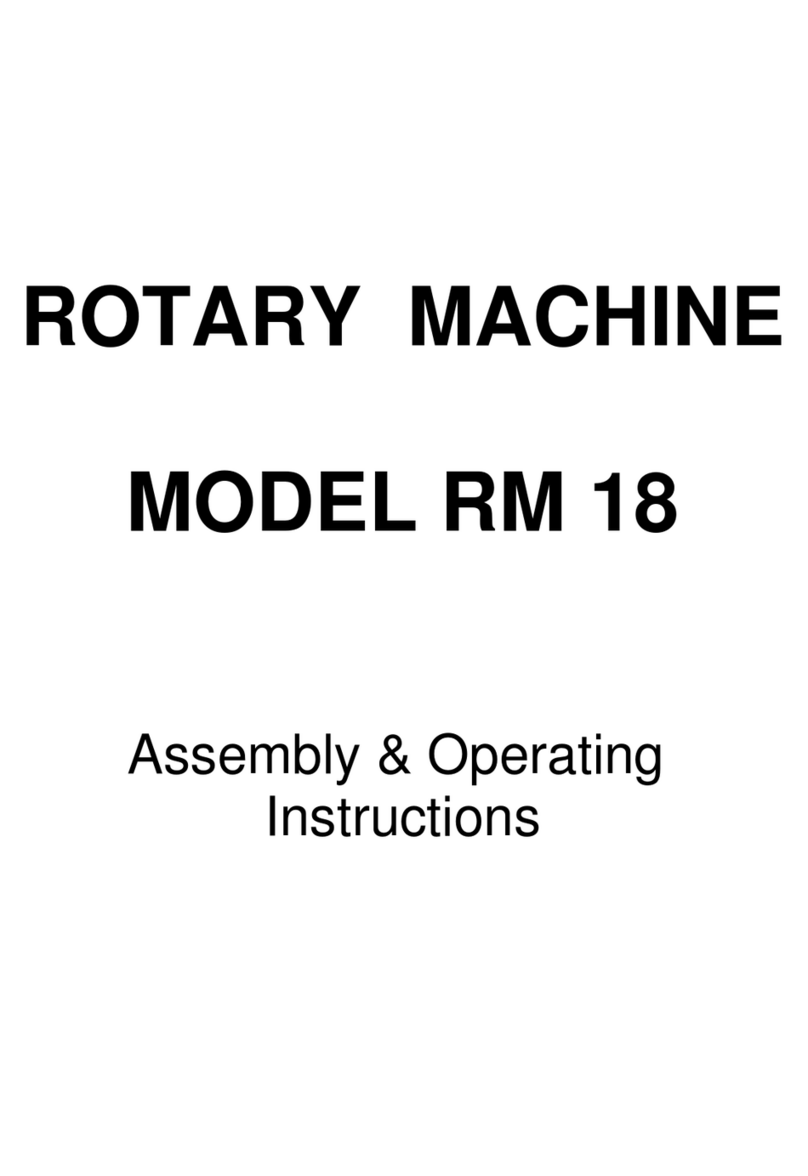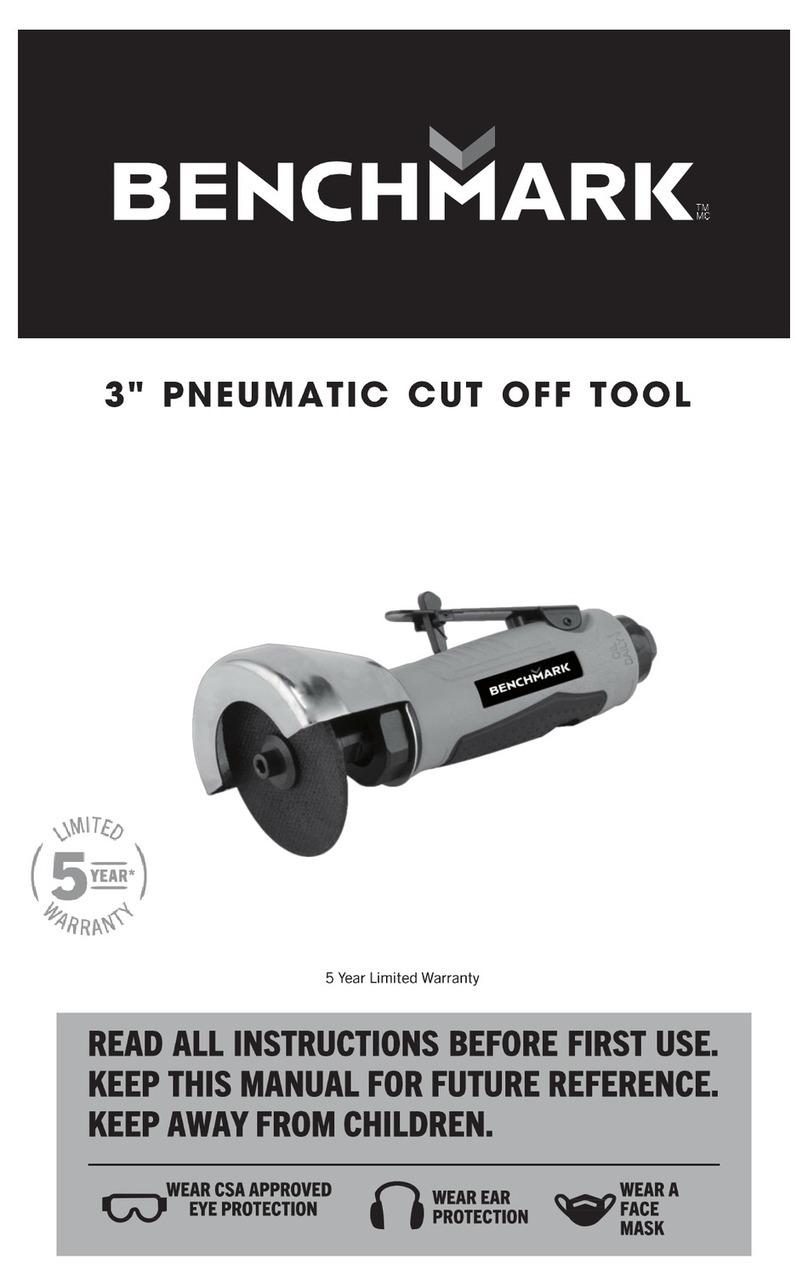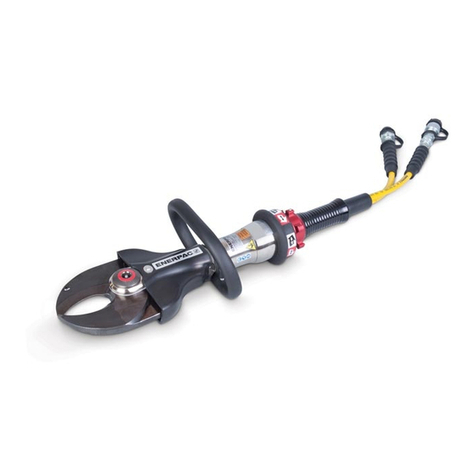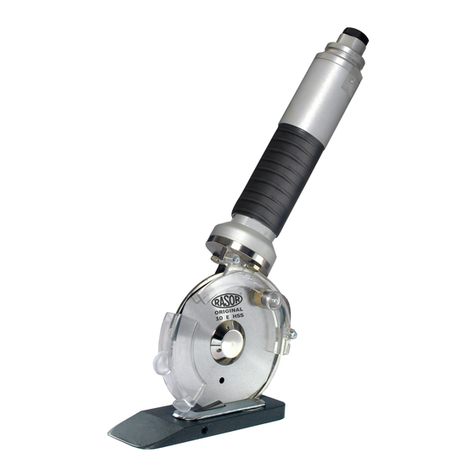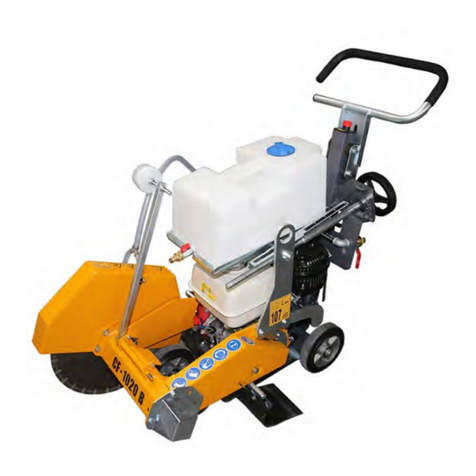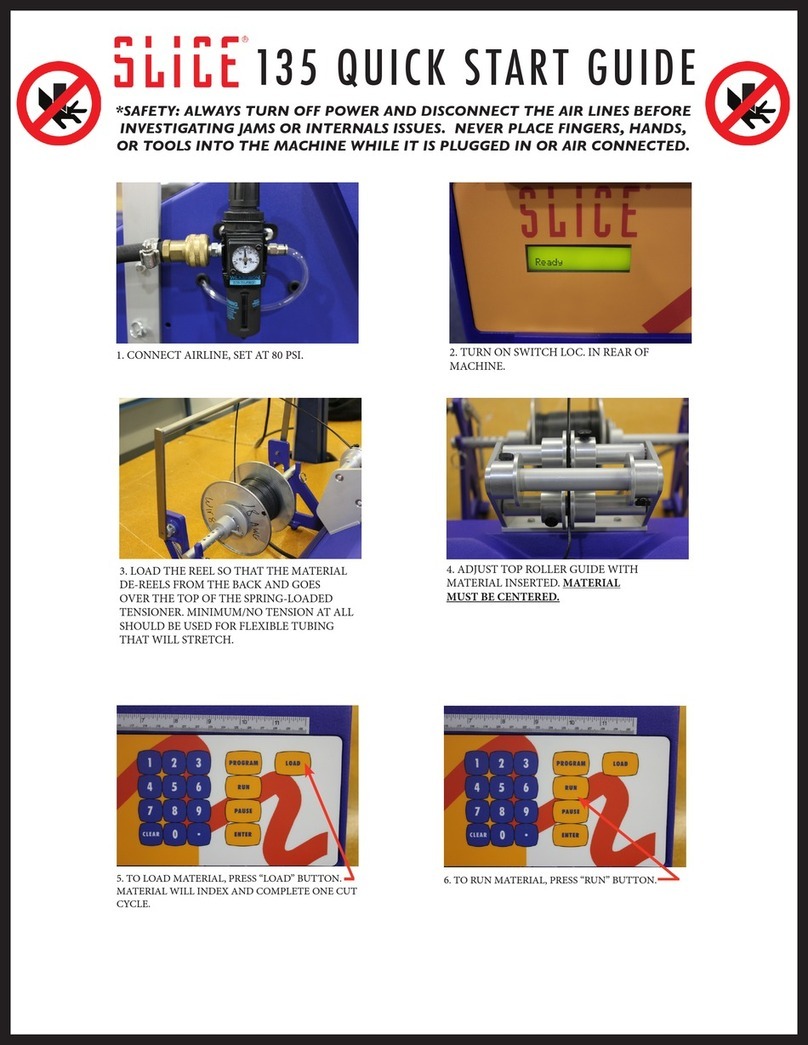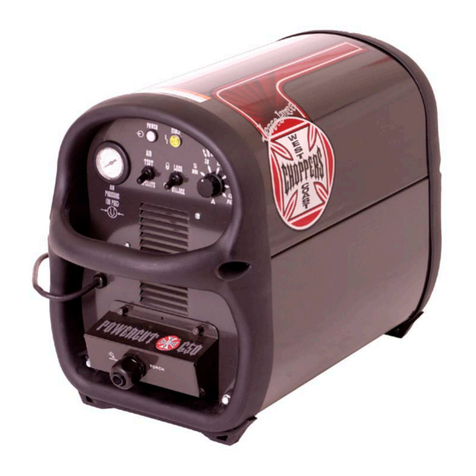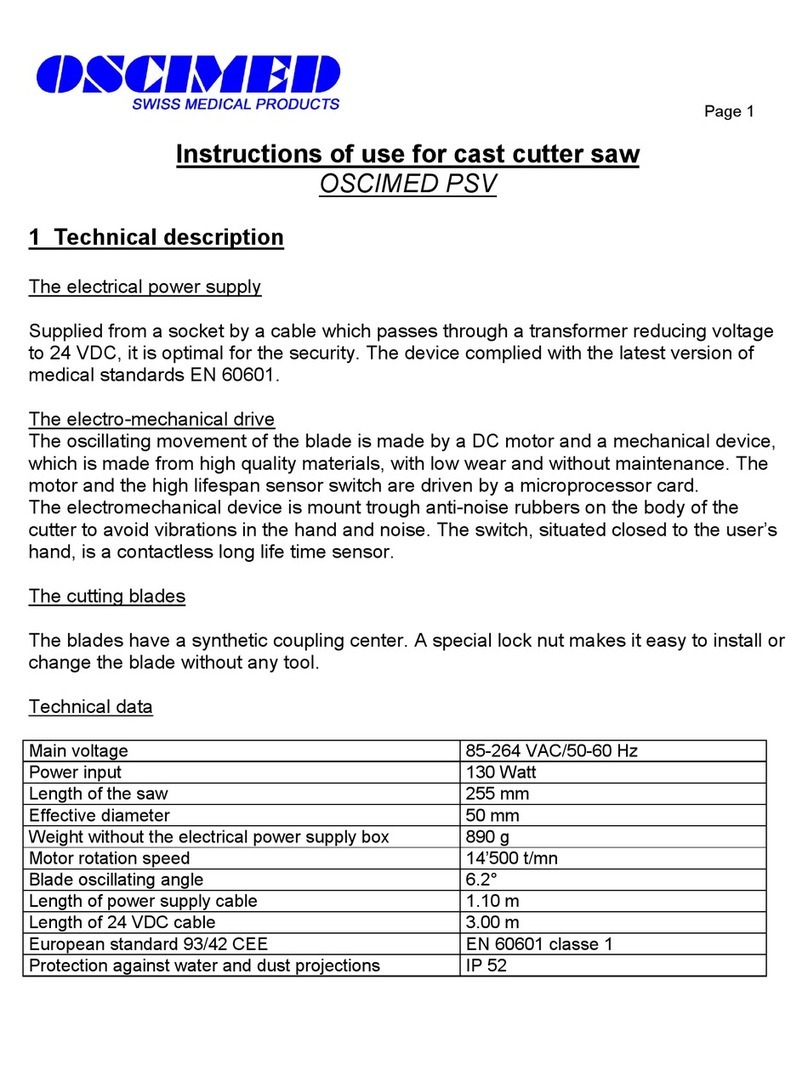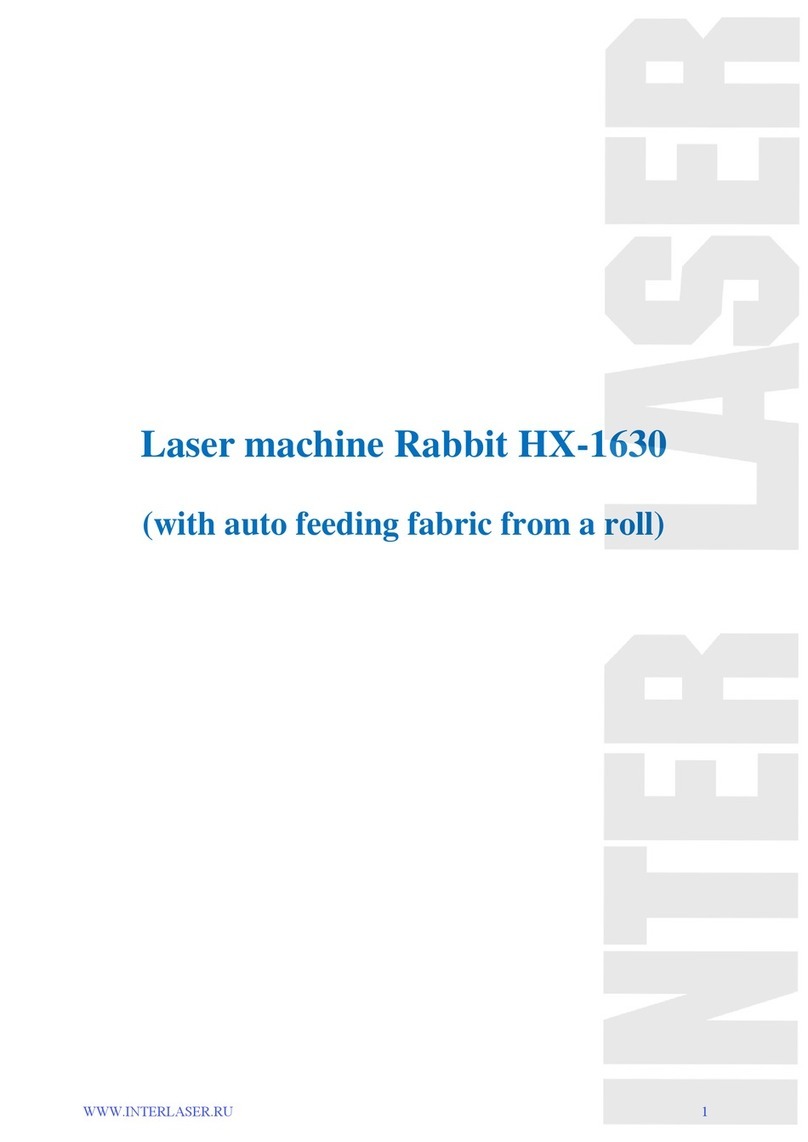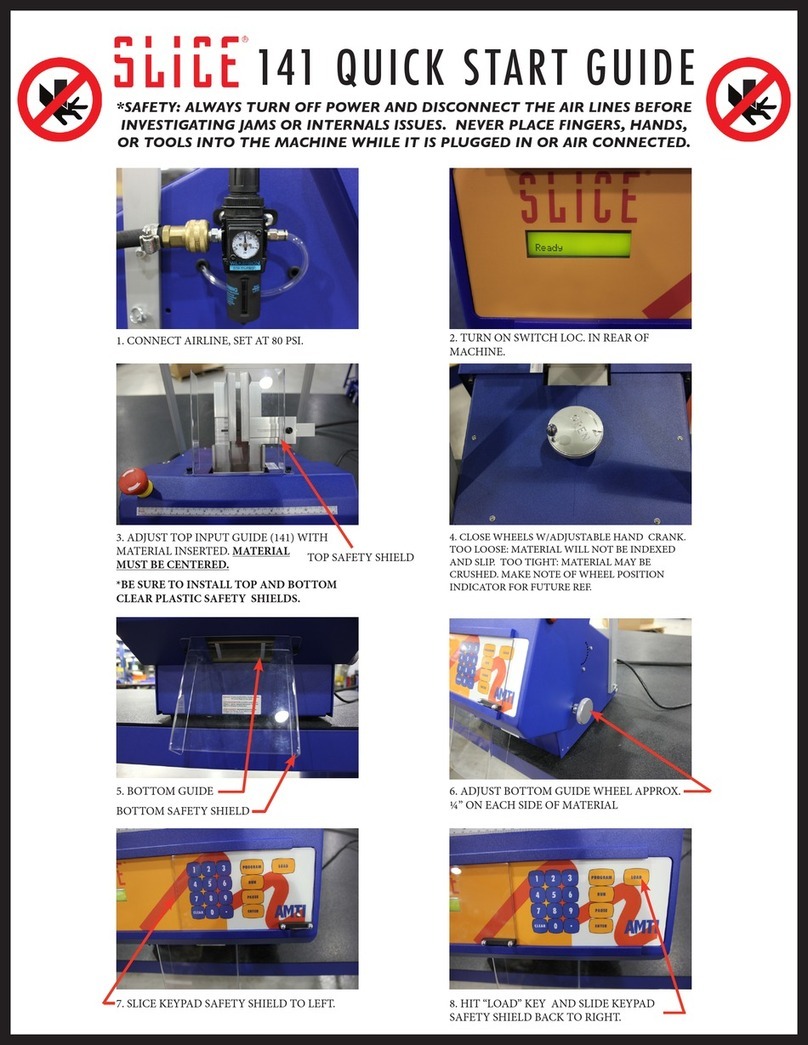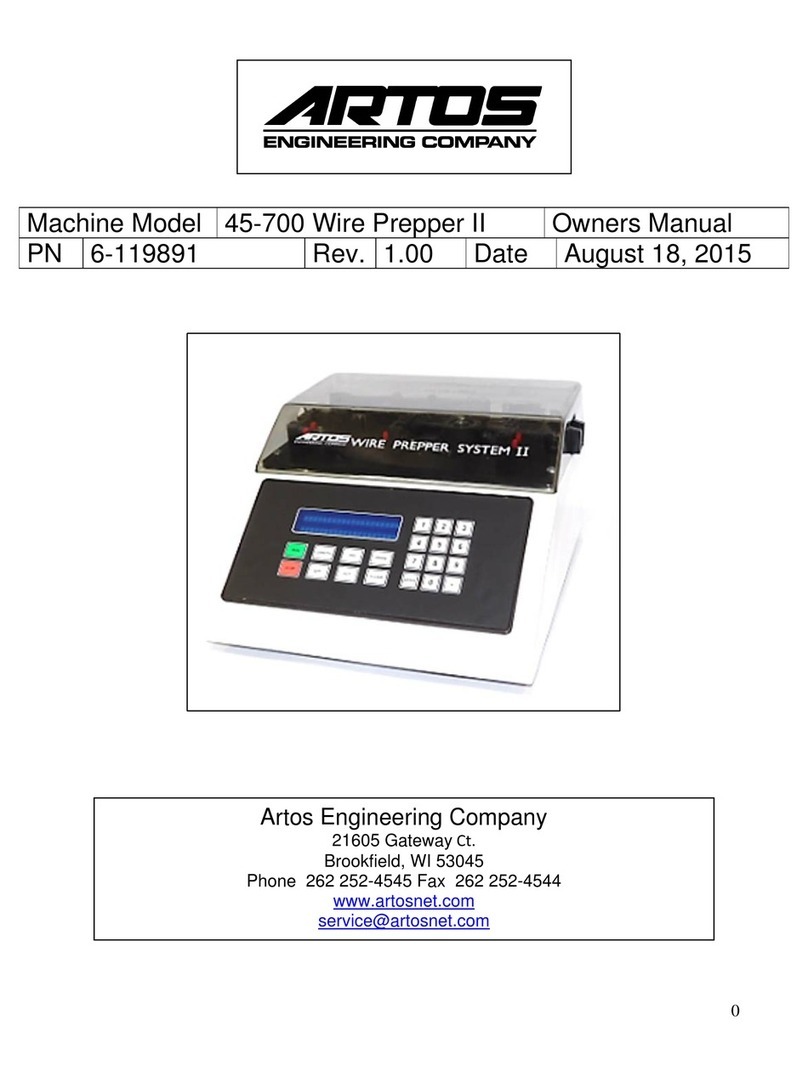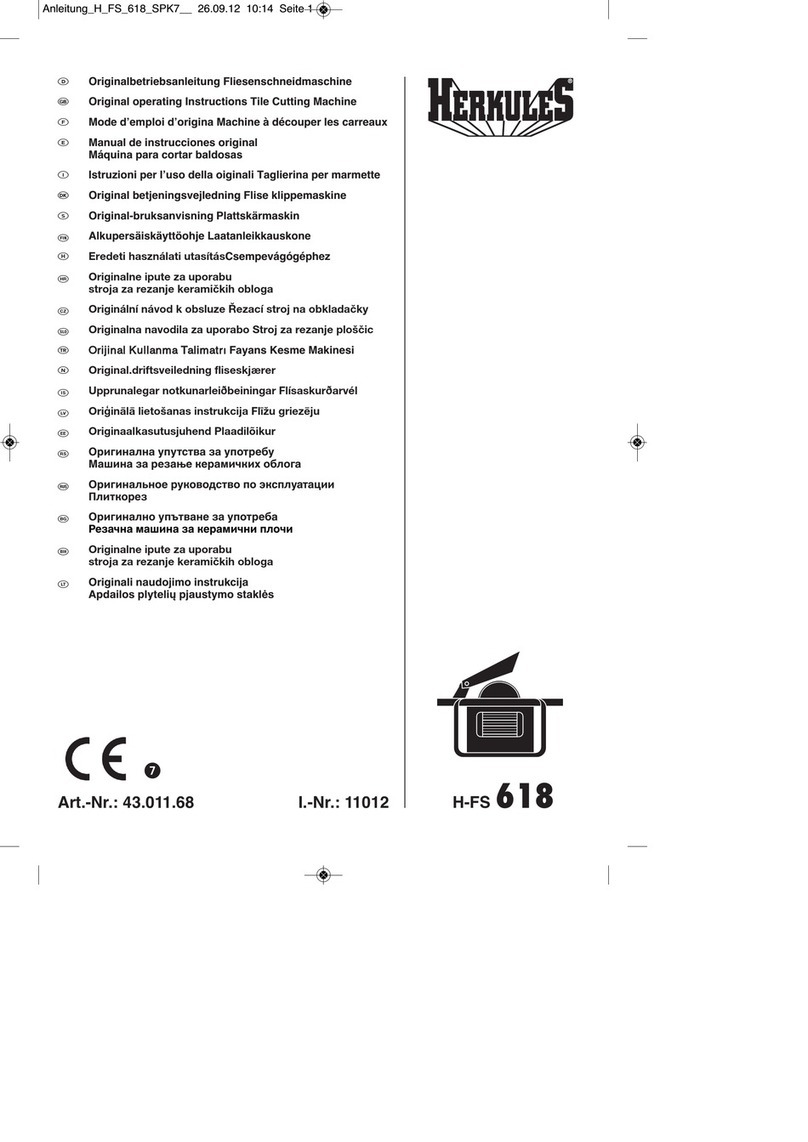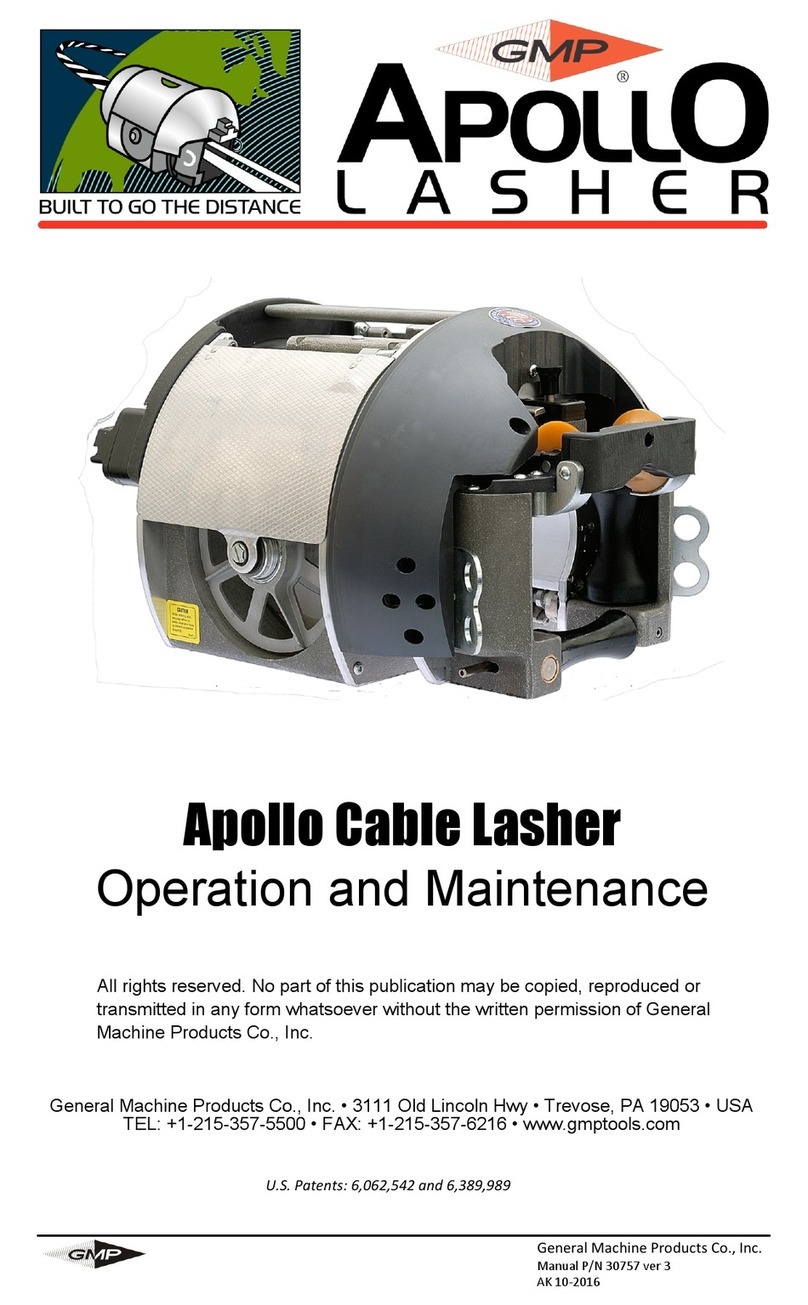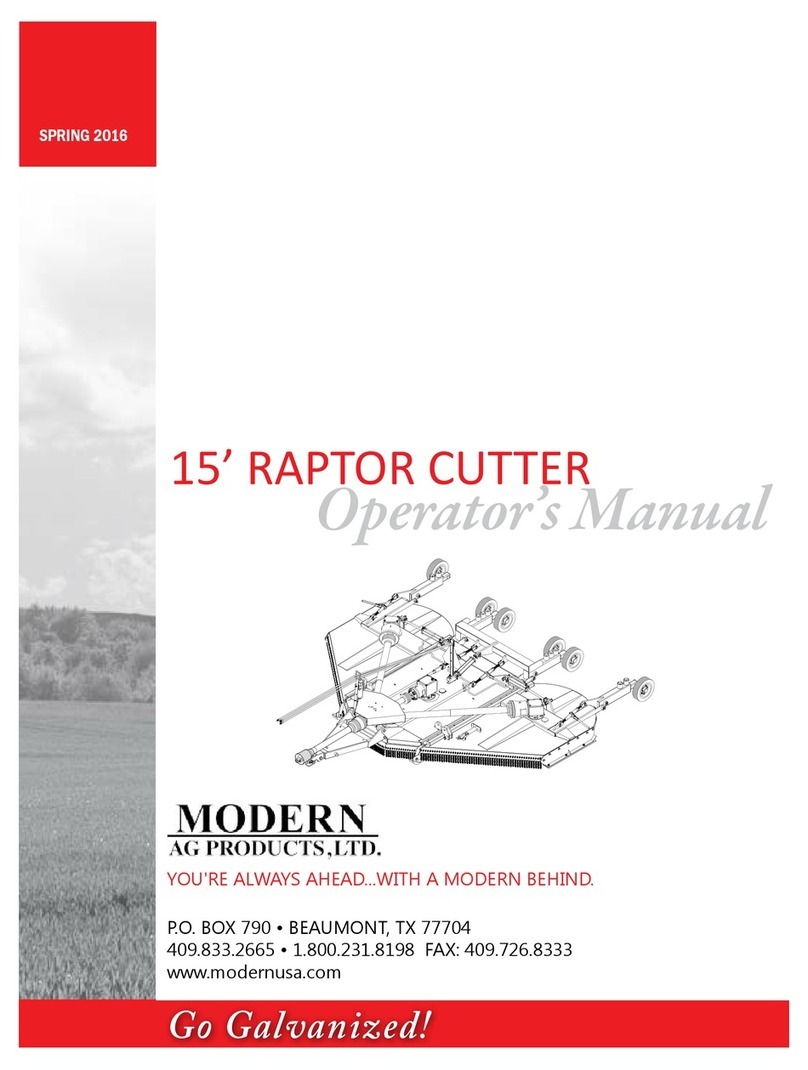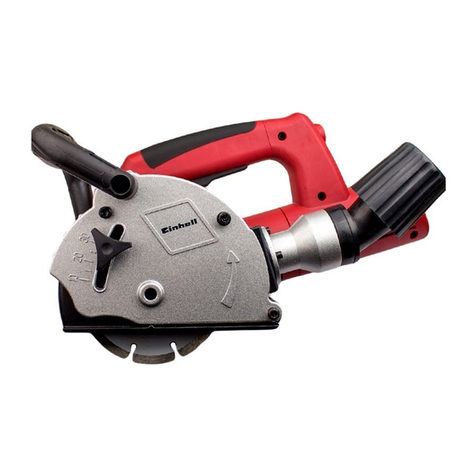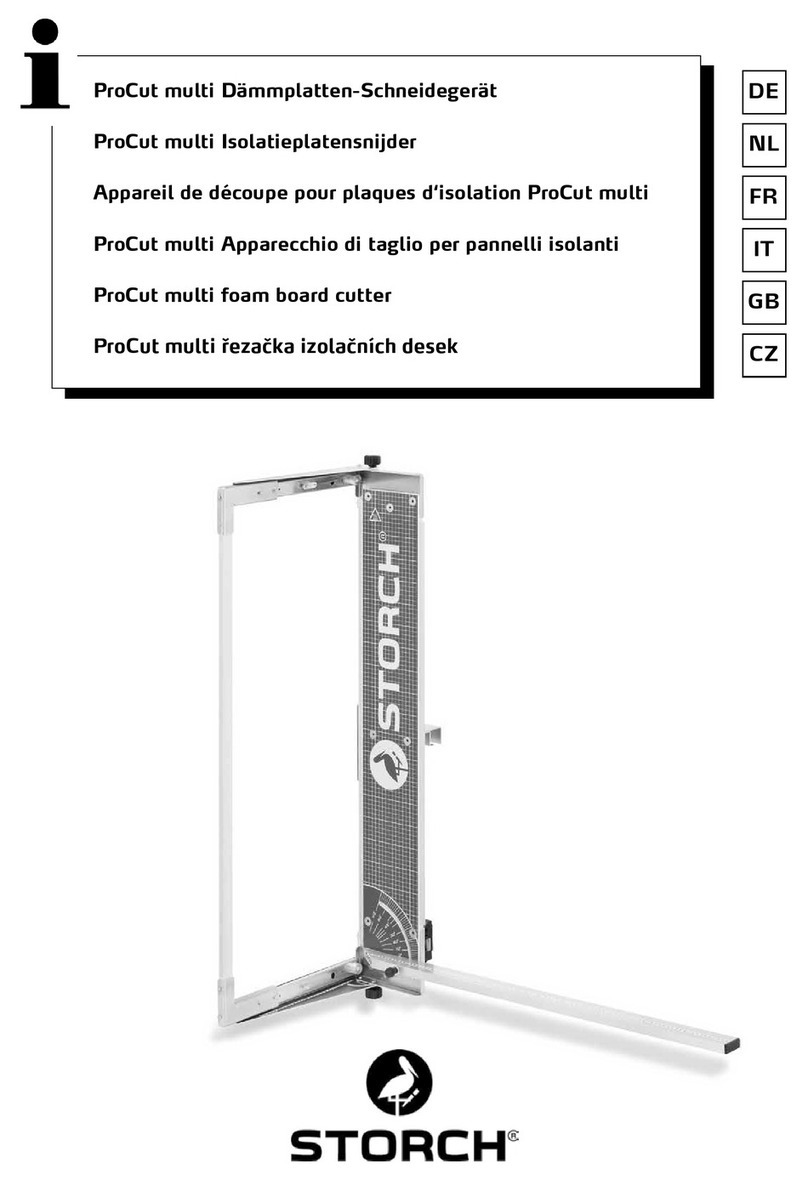Mac Afric ML392C I User manual

MODEL ML392C
Ⅰ
MULTIPLE USE
WOODWORKING MACHINE
SERVICE
MANUAL

1
CAUTION
1 To adjust and maintain after stopping the machine and take the plug off the socket.
2 Fix the milling hood when carriage, surface planing, press planing, sawing and storage (see
below Fig).
3 To mount the protective device during the milling operation.
4 To dismount sawblade if you have to operate the press planing, milling and drill for a long
time.
5 Max. diameter of milling cutter is less than 104mm.
6 Let the milling feeding presser (used as anti-kickback jaw) and the outfeed presser press the
workpiece dependably. The adjusted natural height should be lower than that of the level of
milling cutter.
milling hood

2
Model ML392CⅠmultiple use woodworking machine is widely used for its multiple functions
such as surface planing, press planing, sawing, milling, drilling. Its main advantages are not
only multiple purpose in usage but also light in weight, simple operation and easy
maintenance, it may be used to process all kinds of woodpieces in house building, furniture
making, decoration, wood arts and crafts making.
1 Primary parameters
Max. planing width ................................................................................................ 200mm
Max. planing depth ....................................................................................................3mm
Press planing scale.............................................................................................. 6~90mm
Min. press planing length....................................................................................... 150mm
Max. sawing thickness ............................................................................................. 70mm
Max. sawblade dia.................................................................................................. 250mm
Max. crosscut width ............................................................................................... 270mm
Arbor rotate speed........................................................................................... 3500r/min
Press planing feed speed ...................................................................................6.5m/min
Milling cutter diameter .................................................................................... 74~104mm
Milling thickness scale ........................................................................................6~60mm
Max. milling width ................................................................................................... 40mm
Max. drilling diameter .............................................................................................. 12mm
Max. drilling depth ................................................................................................... 90mm
Milling arbor dia....................................................................................................Φ20mm
Motor power....................................................................... 1.5kW(220V 50Hz; 380V 50Hz)
Net weight................................................................................................................ 135kg
Overall dimension (L×B×H. cm).............................................................. 92×131×97mm
2 Noise & Dust
2.1 Index of acoustic power
Caution: A long exposure to over 85 dB(A) may damage the operator's health, therefore the
use personal protections such as ear plugs, headphones etc. is recommended. The measures
of the sound power emitted in the different machining operations comply with the ISO3746/
1979
Surface Planing
Infeed 89.0dB(A)
Max. level-LpeaK dB less than 110
Sawing
Infeed 91.0dB(A)
Max. level-LpeaK dB less than 110
Drilling
Infeed87.5dB(A)
Max. level-LpeaK dB less than 110
Milling
Infeed 89.5dB(A)
Max. level-Peak dB less than 110

3
2.2 Residual Dust
Average value of the residual dust
during workpiece feeding
Average value of the residual dust
during workpiece outfeeding
Surface planning 0.32mg/m3
Press planning 0.12mg/m3
Sawing 0.34mg/m3
Drilling 0.15mg/m3
Milling 0.46mg/m3
Surface planning 0.42mg/m3
Press planning 0.15mg/m3
Sawing 0.38mg/m3
Drilling 0.13mg/m3
Milling 0.48mg/m3
3 Structure
This machine is specially designed with the structure of plate combined bench type. It is very
convenient and reliable in usage and maintenance. It is mainly made up of front and back
bench, right and left bearing base,right and left wall board, press planing table, sawing table,
arbor, motor and driving system. The machine can be accommodated to either one phase or
three phase motor (1.5kW/1.1kW)
The main driving is by V-belt as chain and gear ways. The feeding of press planing is
automatically. The anti-kickback jaw guarantee the security of operation. The cutter head is
installed on the milling arbor. The milling protective device guarantee the security of milling
operation.
4 Carriage & Installment
During carriage, using lifting hook (Fig.2). To keep the machine balance, handle carefully.
Keep the machine in a wide and arid place. Fix the machine with ground bolt (see Fig.3) On
behalf of carriage, some of the parts are packed with small packing box. In this case, the
customer must mount the dismounted parts in accordance with the stages and means
showed below.
As Fig.15 showing to mount the box base.
As Fig.4 showing, mount milling part first. Fix supporter 35 on left wallboard 36 with bolt 34.
Let milling table 7 parallel with surface planing table, then insert column guide 23 into the
hole of milling table 7. Screw the bolt 28 tightly and then mount presser 11 and push presser
Press Planing
Infeed 83.0dB(A)
Max. level-LpeaK dB less than 110
Outfeed 87.5dB(A)
Max. level-LpeaK dB less than 110

4
8 onto the drilling table 9 and milling table 7 separately. Screw the level moving bolt 27 into
sliding base 29 and make it connected with the open ended screw arbor base of the supporter
35.
Fig.1 Overall Diagram
1.motor 2.lock bolt 3.graduated disk 4.presser 5.sliding table 6.guide7.saw hood 8.lock bar 9.splitter 10.saw
table 11.outfeed table 12.limiting rubber 13.track 14.supporter 15.press planing table 16.planing lock bar
17.auto-feeding bar 18.elevating handle 19.bolt M8×30 20.bearing base 21.V-belt A900 22.bolt M8×50 23.bolt
M8×50 24.V-belt A800
See Fig.5, mount the square iron 12 (two pieces) on the saw table 5 with bolt 14 (four pieces)

5
and bushing 13 (four piece). Connect guide track 11 with square iron 12 by screw 9 (two
pieces) and press plate 10 (two pieces).
Keep the guide track 11 vertically with saw spindle. As Fig.1 showing, dismount the rubber
bushing 12,mount the crosscutting saw table 5 and keep it moving flexible on the guide track
11. Mount the dial scale 3 and presser 4.
As shown in Fig.6,mount the ruler base 3 on the front bench 1 with bolt 2 M6×12 (three
pieces). Don't fixed the bolt 2 first, put the guide 6 which connected with guide base 5 on the
ruler base 3, lock them with lock lever 4, and check if the side of the guide is parallel with the
saw blade. If it is not parallel, adjust the guide base 5 until they are parallel. After mounting,
clean the bench and clean the no painting parts with petrol or abies oil.
Fig.2 Lifting diagram
Fig.3 Ground bolt fixing diagram
5 Electric part
5.1 Electric diagram see Fig.7 a or b
5.2 Caution

6
Pay attention to the voltage, frequency. They should be accommodated with the requirement
and the difference should be not more than ±5%, and earthed dependably. You can use
single phase or three phase motor for the machine. The connection of the electric should be
carried by special technicians. If you stop the machine by SB2, in the situation of the machine
is off, press SB1, you can start the machine in touch form. If you need uniform operation, you
must replace SB2
Fig.4Drilling & Milling diagram
1. hex-head bolt M8×25 2.milling arbor 3.milling hood 4.cutter block 5.spacer 6.nut M18 anti-clockwise
7.milling table 8.push presser (group) 9.drilling table 10.locate fence 11.presser (group)-12. adjustable screw 13.
nut M6 14. hex-head bolt M6×12 15. large spacer 6-140HV 16.press case 17.poke rod 18.hex head bolt
M6×16 19.spacer 6-140HV 20.hex-head blot M8×16 21.post rod 22.column guide 23.column guide 24.saddle
25.set hoop 26. 27.level moving bolt 28.hex-head bolt M8×16 29.sliding base 30.locking bar 31.guide
32.elevator 33.guiding column 34.hex-head bolt M8×25 35.supporter 36.left wallboard
6 Safety rules
6.1 GENERAL SUGGESTIONS
IT IS COMPULSORY THAT THE OPERATOR ACQUIRES THE NECESSARY TRAINING TO USE THIS KIND OF MACHINE BEFORE
STARTING ANY WORK AND HAS THE MINIMUM AGE PROVIDED FOR BY THE LAW OF THE COUNTRY IN WHICH HE IS
WORKING. BEFORE STARTING THE MACHINE CAREFULLY READ THE ENTIRE HANDBOOK OBSERVING THE SUGGESTIONS
GIVEN AS WELL AS THE PLATES EXPOSED ON THE MACHINE.

7
Fig.5 Crosscutting diagram
1.guide lock bar 2.guide part 3.woodpiece 4.saw hood 5.saw table 6.presser 7.dial scale 8.crosscut table 9.screw
M10×20 10.press plate 11.track 12.square iron 13.distance case 14.bolt M8×75
Fig.6 Guide mounting and adjustment diagram
1.front bench 2.bolt M6×12 3.ruler base 4.lock lever 5.guide base 6.guide

8
Fig.a Fig.b
Single-phase motor electric element list (see Fig. a), Three-phase motor electric element list (see Fig. b)
Fig.7 Electric diagram
●THE USE OF ANY MACHINE TOOL WITH ELECTRIC DRIVE CAN INVOLVE RISKS OF DAMAGE TO PERSONS OR THINGS. IT IS
THEREFORE NECESSARY TO ALWAYS PAY THE UTMOST ATTENTION!
●MAKE SURE THAT THE STARTING, STOPPING AND EMERGENCY CONTROLS ARE DISPLACED.
●USE THE MOST SUITABLE CLOTHING FOR THE WORKING ENVIRONMENT AVOIDING LARGE SLEEVES AROUND THE
WRISTS, SCARFS, NECKTIES, BRACELETS, RINGS AND KEEP YOUR HAIR TIED UP WHEN USING THE MACHINE.
●DURING THE USE OF THE MACHINE, ALWAYS ADOPT THE SUITABLE PERSONAL PROTECTION SUCH AS HEADPHONES
OR EARPLUGS, ANTIDUST MASKS, PROTECTION GLOVES, SAFETY SHOES.
●BEFORE STARTING WORK, CHECK THAT THE WORKPIECE DOESNT HAVE METAL INSERTS, NALS, OR KNOTS OR
DANGEROUS CRACKS, ALWAYS MACHINE THE WORKPIECE IN THE DIRECTION OF THE VEINS.
●NEVER MACHINE TOO SMALL WORKPIECES AS THEY ARE DAMGEROUS, NOR TOO BIG OR HEAVY ONES IN RESPECT OF
THE FEATURES OF THE MACHINE, NOR TOO CURVED ONES.
●TO MACHINE LONG WORKPIECES, ALWAYS INSTALL SUITABLE SUPPORTS WITH INFEED AND OUTFEED ROLLERS IN
ORDER TO BALANCE THE WEIGHT OF THE WOOD.
Code
Name
Type & specification
Amount
Fig. a Single-phase motor
Fig.b Three-phase motor
XP
Plug
Single-phase three pole 16A
Three-phase four pole 380V/15A
1
FU
Fuse
RT14-20 2A
RT14-20 2A
1
SA
Change-over switch
Combine with SB1
Combine with SB1
1
SB1
Switch
CK3-3F/380V 13A3-PA
CK3-3F/250V 13A3-PA
1
SB2
E-button
MK/AE-22
MK/AE-22
1
M
Motor
MC90L2/B3
Y90S-2/B3
1

9
●NEVER INTRODUCE HANDS, ARMS, HEAD OR OTHER PARTS OF THE BODY INTO THE MACHINE, ESPECIALLY INTO THE
MACHININH AREA OF THE ROTATING TOOL.
●THE WORKIMG AREA MUST BE WELL-ILLUMINATED. WITHOUT OBSTACLES, CLEAN AND WITHOUT PERSONS IN IT.
NEVER LET KEYS, TOOLS OR WORKPIECES ON THE MACHINE; KEEP THE MACHINE TABLES ALWAYS CLEAN. TAKE THE
PLUG OFF THE SOCKET AFTER STOPPING THE MACHINE.
●BEFORE ANY CLEANING OR MAINTENANCE OPERATION, TURN-OFF THE GENERAL SWITCH OF THE MACHINE AND
DISCONNECT THE PLUG FROM THE FEEDING LINE. MAKE SURE THAT NOBODY MAY TURN ON THE MACHINE
ACCIDENTALLY.
●NEVER LEAVE THE MACHINE UNGUARDED WHEN IT IS ON. AT THE END OF WORK, MAKE SURE THAT NO UNDER FULL
AGE OR UNAUTHORIZED PERSONS MAY REACH THE MACHINE AND START IT, IT IS RECOMMENDED TO KEY THE SWITCH
OF THE ELECTRICAL OUTLET THE MACHINE IS CONNECTED WITH.
●NEVER OPERATE THE MACHINE IF YOU ARE UNDER THE EFFECT OF ALCOHOL, PSYCHOTROPIC MEDICINESOR DRUGS.
6.2 Operator's risks prevention
Although the recommendations stated in par. 6.1, the operator may be subject to the following
risks.
●Cut risk during the adjustment, mounting and removal of the tools and during the cleaning
phase of the machine: Use gloves, keys and special equipment and carry out the operations
with the necessary caution.
●Cut risk during machining: Don’t put your hands on the tools when they are rotating; use
the guards supplied, use gloves and advance the workpiece slowly and carefully.
●Risk of projection of splinters and/or parts of tools: Use the guards supplied; make sure
that they are adjusted and stable; use goggles and assumes suitable positions. Always make
sure that the mounted tools are fixed well, clean, integral and balanced.
7 The use of the machine and prepare before starting
7.1 Change of knives (See Fig.8)
The machine is supplied with 3 already set knives; however, each time it will be necessary to
sharpen or replace them, operate the following way:
●Turn-off the machine and take the plug off the socket, shut off the resources.
●Loose the three screws 5 of tool presser 4 with the wrench of the machine. Then adjust the
knives.

10
Fig.8 Cutter mounting and adjustment diagram
1.straight ruler 2.back bench 3.cutter 4.tool presser 5.bolt M8×10 6.arbor 7.front bench
●Keep the blade in the middle, put the ruler 1 on the back bench 2, rotate the arbor 6, adjust
the length of the knives above the surface of the bench until it can reach the ruler1 on the
back bench 2. Adjust the blade and make it parallel with the back bench or 0.05mm higher
than the back bench on basis of back bench 2. Then lock the three screws 5 of tool presser 4.
Turn the middle one first, then the both sides. Repeat the operation and mount the three
knives.
Caution:
●Never mix knives of different types and series.
●Sharpen the knives in a way that the sharpening height and the angle (38°~42°) are
always the same for each series.
●The knives can be sharpened up to a minimum height of 21mm (original dimensions 260×
30×3mm).
7.2 Surface planing (Fig.9)
Surface planing occurs with one or more passes to straighten the first and the second side of
a rough piece of wood. After obtaining the complete flatness on the first side, pass on to
planing the second side at 90° to the previous one. Let the first side against the guide 7 and
the second side against the infeed table 4, put the left hand in front of the right one, push the
wood lightly. After the wood passing guard 3. Place left hand forward to press the wood on
outtable. Push the wood by right hand continually. Never put hand under guard 3.
You should move the guide to the right side of the table 4 and lock it by bar 6 make full use of
bridge guard 3.
Caution: Let the smooth surface of guide 7 face leftwards (Fig.9) dismount sawblade. Drill bit
cutterpan and milling hood. Mount saw cover and arbor cover. Let button 1 in the position of
R (Fig.14).
●For planing operations on the wide side with a height of up to 60mm. Adjust guard 3
laterally against guide 7 and rest it on the workpiece.

11
Fig.9 Surface planing diagram (for wide workpiece)
1.spindel hood 2.bridge guard supporter 3.bridge guard 4.front bench 5.ruler base 6.lock lever 7.sawing and
planing guide 8.lock lever 9.sawing safety hood 10.sawing table 11.emergency stop switch
Fig.10 Surface planing diagram (for thin and thick workpiece)
1.spindle hood 2.bridge guard supporter 3.bridge guard 4.front bench 5. sawing and planing guide 6.lock lever 7.
ruler base 8.lock lever 9.sawing safety hood 10.sawing bench 11.emergency stop switch
●For planing operations on the wide side with a height of over 60mm, adjust guards against
the workpiece and rest it on the machine table (Fig.10).

12
●Operator should stand at the position of Fig.9. Instructions for use
●Always advance the wood uniformly and slowly.
●Check that the wood doesn't have splittings or dangerous knots and always pass the
concave part towards the tables.
●Avoid to pass short and small-dimensioned workpieces and, if necessary, use special flat
holders.
●For long workpiece use supports in outfeed.
●Keep the knives sharp and don't have cracks.
●For any sudden trouble or accident, press the E-button 11.
●At the end of work, turn-off the machine and clean the table.
●At the end of work, cover the knives with guide 3.
7.3 Press planing (Fig.11)
Fig.11 Press planing diagram
1.front guard 2.front bench 3.press planing table 4.outfeed roller 5.bridge guard 6.cutter spindle 7.infeed roller
8.anti-kickback jaw 9.back bench 10.back guard
This operation is necessary for machining the third and fourth side of the wood piece which is
already planed on the first and second side in order to obtain the finished workpiece.
Preparation
●Turn-off the machine and make sure that nobody may start it accidently.
●Remove the drill bit and sawblade, mount spindle hood 1 and cover 9 (Fig.9)
●Cover the arbor 6 with bridge guide 5. The bridge guide is 3~4cm apart from the arbor.
●Turn-up the guide 10.
●Check that anti-kickback jaw 8. They should be free to fall down with their own weight. If
not, clean them with brush.

13
●Adjust the press planing table 3 according to the workpiece height to be obtained. Lock the
table well after adjustment. For finishing passes, give a removal of about 1mm.
●Insert the wood driving rollers by pulling out lever.
●The operator should stand at the position of Fig.11.
●At the end of work, separate the driving gears.
Instruction for use.
●Check that the wood doesn't have cracks or dangerous knots.
●Pass the machined part of the wood on the press planing table.
●Don't machine too short workpieces, the min. length is 150mm, while for long ones use
outfeed supports.
●Keep the knives sharp.
●Button 1 should be positioned in position. For any sudden trouble or accident,press the
button 2 (Fig.14).
●At the end of work, turn-off the machine, take the plug off the socket, clean the machine.
7.4 Sawing (Fig.12)
Fig.12 Sawing diagram
1. spindle hood 2. bridge guide supporter 3. bridge guide 4. infeed table 5. ruler base 6. lock bar 7. sawing &
planing guide 8. lock bar 9. saw cover
Blade changing
●Turn-off the machine and take the plug off the socket, dismount saw cover, raise sawing
table, wear leather gloves, loose blade lock nut.

14
●Remove flange and blade, clean it well.
●Mount blade and lock nut again, screw the lock nut tightly, down the bench and lock it.
●Center the splitter knife. If not, loose the fixing nut, adjust it.
Preparation
●Turn-off the machine and take the plug off the socket.
●Mount spindle hood 1 and guide 3, then cover the guide 3.
●Mount saw cover 9 on the splitter knife. Adjust the knife and position it at 2mm from the
blade, tighten the lockbar again.
●Adjust guide 7 according to the degree of ruler 5. Guide 7 is used for parallel sawing. Lock
guide 7 by bar 6, making the larger surface of guide 7 towards right side.
Caution: Make the turn-button 1 in the position of R (Fig.14). Clip the workpiece well when
angle cutting operation (Fig.5).
●Connect the chip suction plant with cover 9 and the below sawing dust hole, the hole Φ of
cover 9 is 40mm,the below sawing dust hole is Φ80mm.
●Take the position as Fig.12 showing during operation.
Instruction for use
●Wear goggles.
●For too short workpiece, use push board please.
●For long workpiece, use outfeed supports.
●Check that the wood doesn't have cracks or dangerous knots.
●Make the wood advance uniformly and slowly.
●Remove off-cuts and cut pieces in contact with the saw blade by means of wood and never
use your hand to do so.
●Do not remove the workpiece when the cut already started.
●To obtain clean cuts without chippings, use blades having short pitch tooth.
●Keep knives sharp enough.
●Be sure the blade is in good condition.
●Press the E-button if there is something wrong.
●Mount sawing cover 9 well enough.
●At the end of work, turn-off the machine and take the plug off the socket, maintenance the
machine.
●Dismount saw blade, mount saw cover 9 as Fig. 9 showing. Cover the arbor by guide 3.
8 Milling (Fig.4)
8.1 Preparation
●As Fig.13 showing, lock guide 8 by lockbar 7. Let the cover 6 fixed onto guide 8 cover the
arbor completely. Fix the hood 10 onto the splitter knife by lockbar 9.
●Dismount arbor hood 1 (Fig.9).
●Adjust the cutters, make the sides of the cutters align with the side surface of the toolpan,
Fig.13Drilling Protective diagram

15
1.drill bit 2.drill hood 3.bolt M8×12 4.front bench 5.ruler base 6.arbor cover7.lock lever 8.sawing & planing
guide 9.lock lever 10.saw safety cover 11.sawing table
let the cutters extend over the toolpan at the same height, when straight edge cutter need to
be mounted, the diameter of cutter edge is 74mm, when shaped edge cutters need to be
mounted, the max. diameter of tool edge is not more than 104mm.
●Mount toolpan 4 and spacer 5 in proper order and then lock by nut 6.
●Adjust the position between bench and tool pan according to the width of the workpiece,
then tighten the bench.
●Mount milling hood 3, let the milling feeding presser (used as anti-kickback jaw) and the
outfeed presser press the workpiece dependably. The adjusted natural height should be lower
than that of the level of milling cutter.
●Change-over switch 1 in the position of R (Fig.14). Infeed direction is the same as press
planing direction. The milling depth is about 3mm. The Max. depth is not more than 5mm.
●The operator should stand at the left and back side of the machine.
8.2 Instruction for use
●Wear goggles.
●Keep the knives sharp, clean and the same weight.
●Check that the wood doesn't have splitting or dangerous knots.
●Always advance the wood uniformly and slowly.
●Never low the table before the spindle stops completely.
●Press button 2 (Fig.14) if there is something wrong.
●Be sure to keep the arbor in well condition and covers in good position and fixed well.
●At the end of work remove the cutter, clean chips, mount spindle hood.
9 Drilling
Hole or half-holes can be carried out

16
Fig.14 Switch mounting diagram
1.change over switch 2.switch button 3.left wall board
●Turn-off the machine and take the plug off the socket.
●Cover the arbor by cover.
●Mount drill bit 1 and tighten by lock screw (Fig.13).
Caution: The max. Φ12mm drill bit clockwise is permitted.

17
●Mount hood 2 and fix it by screw 3 (M8×12 see Fig.13).
●Make marks on workpiece before drilling, then clip the work piece on bench.
●Adjust the height and position of bench 7 by handwheel 32 (Fig.4).
●Operate the lateral and longitudinal handles.
Caution: During waist shape hole drilling operate the lateral handle only
●Start the machine, stand at the left side of the machine.
Instruction for use
●Be sure to clip the woodwell. Never clip too long woodpiece. Avoid dangerous knots.
●Wear working clothing. Advance wood uniformly and slowly.
●Press button 2 (Fig.14) if there is something wrong.
●Keep the bit sharp enough.
●At the end of work, turn-off the machine, remove the bit. Mount spindle hood.
10 V-belt tension adjustment
As shown in Fig.1, loose bolt 19,22,23 (each two pieces), rotate motor 1 around bolt 23 to
make the V-belt 24 tension lock the bolt 22, 23. Move the transfer bearing base 20 to make the
V-belt 21 tension.
Fig.15 box-type base fixing diagram
1. bolt M8×25 2. spacer 3. cover 4. bolt M6×10 5.nut 6. spacer6-140HV 7. front frame plate
8. bolt M6×16 9 sheet 10. door 11. base plate 12. back frame plate

18
11 Maintenance & attendance
11.1General maintenance
●Take the plug off the socket. Completely shut off the electric resource.
●Clean the wood chips after work. Don't use iron brush on the anti-kickback jaws.
●Lubricate rotate part every month, apply grease on chain, gear, nut and bushing with
hairbrush.
●Cover the V-belt to avoid polluted by oil when maintenance.
●When the table is not used for a long time, please brush the anticorrosive paint.
11.2 Special maintenance
●This work should be operated by special man, including some accident.
●Take the plug off the socket before operating, completely shut off the electric resource.
●Check the V-belt, motor every 500 hours, Dismount the V-belt hood when check. If
something is wrong, please repair or change.
12 Major Standardization Products & Fragile Parts
Name
Specifications
Amount
Mount position
Radial ball bearing
80204
2
Planing arbor
Radial ball bearing
60203
4
Thickness feed drive
V-belt
A900
1
Thickness feed drive
V-belt
A800
2
Plane drive
Planer tool
210×30×3
3
Planing arbor
Saw blade
250×3×25.
1
Planing arbor
13 Tools to be used
The following tools are to be used during adjustment and maintenance.
Name
Specification
Name
Specification
Flat head screw driver
100×6 75×4
Double ends solid wrench
14×17; 10×12
Crosshead screw driver
100×8
Monkey wrench
250×30
Allen key
5; 6; 8
Lead weigh
0.5kg

19
14 Machine Faults & Repairing Measures
Take the plug off the socket before repairing and shut off the electric source
No.
Fault
Reason
Repairing Measure
1
The motor does not
revolve although its
switch is turned on
a. AC supply not electrified or the
fuse has been blown
b. The wire connecting is relaxed or
broken
c. Contact fault of the switch
a. Check the power source
and fuse
b. Check the wire
c. Check the switch
2
The motor is over
heated
a. There are short inside the motor
b. The motor is overloaded
c. AC supply is under voltage
a. Check the motor
b. Reduce the amount to
feed
c. Check the supply
voltage
3
Bearings are over
heated
a. Bearings has been insufficiently
b. The bearing inside is dirty
Apply or ex change
lubricant
4
Rotation is under
speed
a. AC supply is under voltage
b. The belt is loose
a. Restore the supply
voltage
b. Tauten the belt
5
Planing quality gets
worse
a. The tool edge is dulled or there are
gaps
b. Tools are fitted or adjusted
improperly
a. Sharpen the planer tool
b. Refit the planer tool
6
The machine is
charged
Insulation of certain parts of the
electric system is impaired and
electricity leaked away
Repair or replace them
Table of contents
Other Mac Afric Cutter manuals
